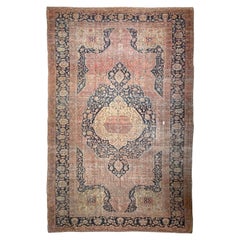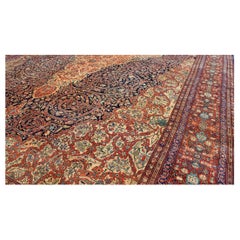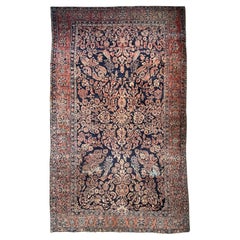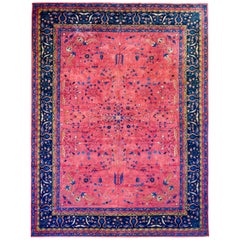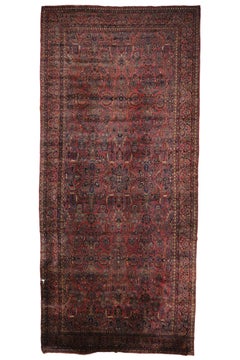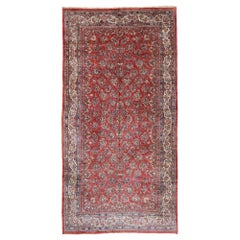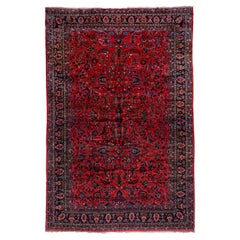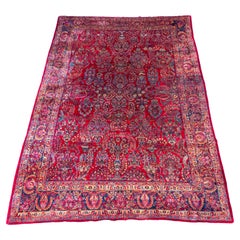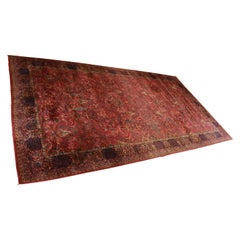Palace Size Sarouk Rug
Ancient Palace Size Antique Ferahan Sarouk Rug, c. 1900-1915
Located in Milwaukee, WI
Ancient Palace Size Antique Ferahan Sarouk Muted Natural Dyes Elegant & Old World Gem
About
Category
20th Century Sarouk Farahan Rugs
Materials
Wool
Palace-Sized Extremely Finely Woven Antique Sarouk-Farahan Persian Rug
Located in Atlanta, GA
Palace-Sized Extremely Finely Woven Antique Sarouk-Farahan Persian Rug . Rug M14-0303,
Measures
Category
Antique Late 19th Century Persian Sarouk Farahan Persian Rugs
Materials
Wool
Masterful Palace Size Royal Mohajeran Sarouk Rug, circa 1920's
Located in Milwaukee, WI
Masterful Palace Size Royal Mohajeran Sarouk with Peacocks, Butterflies, Cacoons, & Zoroastrian
Category
20th Century More Carpets
Materials
Wool
Early 20th Century Palace Size Larestan Rug
Located in Chicago, IL
A palace size early 20th century Indian Larestan rug with a beautifully finely rendered floral
Category
Vintage 1910s Persian Sarouk Farahan Indian Rugs
Materials
Wool
Oversized Antique Persian Sarouk Rug Hotel Lobby Size Carpet
Located in Dallas, TX
highly antique Persian Sarouk palace size rug with Art Nouveau style features an intricate center
Category
Early 20th Century Persian Sarouk Farahan Persian Rugs
Materials
Wool
Antique Persian Sarouk Rug Hospitality Size Carpet 12x23, 11'08 x 22'10
Located in Dallas, TX
naturalistic flowers and an opulent color scheme, this hand-knotted wool antique Persian Sarouk Palace size rug
Category
Early 20th Century Persian Sarouk Farahan Persian Rugs
Materials
Wool
Palace Sized Antique Persian Red Lilian Carpet, circa 1920s
Located in New York, NY
" Sarouk-style interwar carpet shows palmettes alternating with forked arabesques.
Category
Early 20th Century Persian Sarouk Farahan Persian Rugs
Materials
Wool
Recent Sales
Antique Oriental Persian Handwoven 15ft Palace Size Sarouk Rug Carpet Circa 1920
Located in Portland, OR
A fine antique palace size handwoven Persian Sarouk carpet, circa 1920.
The carpet is 15ft in
Category
Vintage 1910s Persian Sarouk Farahan Persian Rugs
Materials
Wool
Karastan Sarouk Palace Size Rug, Circa 1950s
By Karastan
Located in South Bend, IN
A gorgeous Persian Sarouk style room size rug
By Karastan
USA, Circa 1950s
Classic design
Category
Mid-20th Century American Sarouk Farahan Persian Rugs
Materials
Wool
Vintage Hand-Knotted Persian Sarouk Palace Size Rug, Circa 1940s
Located in South Bend, IN
A gorgeous vintage hand-knotted Persian Sarouk room size rug
Circa 1940s
Classic floral design
Category
Vintage 1940s Unknown Sarouk Farahan Persian Rugs
Materials
Wool
Antique Persian Sarouk Rug with Art Nouveau Style, Persian Palace Size Rug
Located in Dallas, TX
76840 Antique Persian Sarouk Rug with Art Nouveau Style - Persian Gallery Palace Size Rug. This
Category
Early 20th Century Persian Sarouk Farahan Persian Rugs
Materials
Wool
Palace Size Fine Antique Mohajeran Sarouk Persian Carpet, c1900
Located in Big Flats, NY
Palace size antique finely woven hand-knotted wool Mohajeran Sarouk oriental carpet features
Category
Early 20th Century Persian Persian Rugs
Materials
Wool
Pre-WWII Antique Palace Size Sarouk Persian Carpet, 17'2"x10'2", c1900
Located in Big Flats, NY
Pre WWII antique palace size Sarouk Persian oriental carpet rug features detached floral spray
Category
Early 20th Century Persian Persian Rugs
Materials
Wool
Antique Palace Size Hand-Knotted Wool Sarouk Persian Carpet, circa 1930
Located in Big Flats, NY
Antique Sarouk Persian carpet features traditional single centre medallion atop a covered field of
Category
20th Century Persian Persian Rugs
Materials
Wool
Antique Hand-Knotted Persian Sarouk Palace Size Rug, Circa 1930s
Located in South Bend, IN
A gorgeous antique hand-knotted Persian Sarouk room size rug
Circa 1930s
Classic design with
Category
Vintage 1930s Sarouk Farahan Persian Rugs
Materials
Wool
People Also Browsed
Art deco murano glass brass chandelier by Ercole Barovier, Italy, 1940s
By Ercole Barovier
Located in Nicolosi, IT
Art Deco Murano Glass Brass Chandelier by Ercole Barovier, Italy, 1940s
Step into the elegance of 1940s glamour with this exquisite Art Deco chandelier by Ercole Barovier, an iconic...
Category
Vintage 1940s Italian Art Deco Chandeliers and Pendants
Materials
Brass
$830
H 35.44 in W 15.75 in D 15.75 in
Maison Bagues French Bronze and Brass Neoclassical Table on Wheels
By Maison Baguès
Located in Miami, FL
Maison bagues French bronze and brass neoclassical table on wheels.
Category
Vintage 1950s French Neoclassical Side Tables
Materials
Brass, Bronze
PMPT Flush Mount
By Lumfardo Luminaires
Located in Los Angeles, CA
Part of Lumfardo Luminaries contemporary collection, the PMPT Flush Mount is a conical flush mount fixture in the spirit of Paavo Tynell of the Scandinavian Modern tradition.
Made t...
Category
21st Century and Contemporary American Mid-Century Modern Flush Mount
Materials
Brass
Rare T.H. Robsjohn Gibbings Bleached Walnut & Vellum Strap Sofa Settee
By T.H. Robsjohn-Gibbings
Located in Palm Springs, CA
A rare, likely custom ordered Sofa or Settee, designed by T.H. Robsjohn Gibbings with a bleached Walnut frame and Vellum Strapping. Stunning, elegant neo-classical design. One long ...
Category
Vintage 1940s British Settees
Materials
Walnut
$25,000
H 29 in W 81 in D 33 in
LARGE STUNNING ViNTAGE RALPH LAUREN HAND DYED BROWN LEATHER FOOTSTOOL OTTOMAN
By Ralph Lauren
Located in West Sussex, Pulborough
Royal House Antiques
Royal House Antiques is delighted to offer for sale this stunning Vintage Heritage hand dyed brown leather Ralph Lauren LARGE footstool or ottoman
Please note...
Category
20th Century Victorian Footstools
Materials
Leather, Hardwood
$3,239
H 15.75 in W 27.96 in D 27.96 in
Custom Made Modern English Arm Sofa in Performance Linen Velvet - 86"
By Bloom Home Inc
Located in Old Town Orange, CA
This beautiful english arm sofa has a modern twist, with its single bench cushion, and beautiful curved apron sides. It’s upholstered in a Linen Velvet Performance fabric.
Shown in...
Category
21st Century and Contemporary American Sofas
Materials
Linen, Velvet
$4,900 / item
H 34 in W 86 in D 42 in
Pair Cast Bronze Art Deco Wall Panels Birds, Squirrels & Storks Floral Details
Located in Toledo, OH
Pair cast bronze Art Deco wall panels with openwork details of squirrels, birds, storks and floral designs. Stamped #P286898 9 on the back.
Category
20th Century Unknown Art Deco Wall-mounted Sculptures
Materials
Bronze
$4,250 / set
H 15.25 in W 13.5 in D 1 in
GEORGE SMITH CHELSEA 3 SEAT SOFA IN ORIGINAL UPHOLSTERY PART SUiTE
By George Smith
Located in West Sussex, Pulborough
Royal House Antiques
Royal House Antiques is delighted to offer for sale this lovely George Smith Signature Scroll arm sofa which is one of a pair in floral upholstery with feather ...
Category
20th Century English Country Sofas
Materials
Upholstery, Beech
$10,332
H 32.29 in W 80.91 in D 38 in
Unique Late 19th-Early 20th Century Gilt Bronze Cartel Clock by François Linke
By François Linke
Located in Long Island City, NY
A Palatial and Unique Late 19th / Early 20th Century Gilt Bronze Cartel Clock By François Linke
François Linke
The heavy and great quality bronze clock is topped by an urn with ram...
Category
Antique Late 19th Century French Belle Époque Wall Clocks
Materials
Bronze
$55,000
H 43 in W 17 in D 9 in
Pair of Curvaceous Mid Century Oak Lounge Chairs
By Jacques Adnet
Located in Atlanta, GA
Pair of Curvaceous Mid Century Oak Lounge or Occasional Chairs, American, circa 1950s. These chairs are currently being reupholstered and can be completed in your fabric. Simply send...
Category
Vintage 1950s American Art Deco Lounge Chairs
Materials
Upholstery, Wood, Oak
Ralph Lauren Chesterfield Sofa
By Ralph Lauren
Located in Hartville, OH
Gorgeous Vintage Chesterfield Sofa with Deep Button Tufts, Rolled arms and Brass Casters. Finished in a Cognac leather. Unsigned, believed to be Ralph Lauren.
Category
1990s American British Colonial Sofas
Materials
Leather
Forsyth Mushroom Pouf Ottoman in Zebra
Located in SAINT LOUIS, MO
This Forsyth mushroom pouf ottoman was created and designed by the Forsyth design team. Each ottoman is handcrafted in Saint Louis. A cute decorative piece for any room adding textur...
Category
2010s American Ottomans and Poufs
Materials
Zebra Hide
English Georgian Mahogany Gadrooned and Upholstered Tester Bed, Circa 1800
Located in Charleston, SC
English Georgian mahogany four-poster bed with a carved molded inset headboard, tapered head post, serpentine gadrooned and upholstered tester with a centered carved urn & swags, dec...
Category
Antique Early 1800s English Georgian Beds and Bed Frames
Materials
Upholstery, Mahogany
$26,000
H 102 in W 61.5 in D 79 in
Fine French 19th-20th Century Louis XVI Style Giltwood Carved Centre Hall Table
Located in Los Angeles, CA
A fine French 19th-20th century Louis XVI style giltwood carved centre hall table. The rectangular shaped intricately carved frame with an X-stretcher centre with a urn, all surmount...
Category
Antique Early 1900s French Louis XVI Center Tables
Materials
Marble
$14,985 Sale Price
49% Off
H 31.5 in W 55 in D 32 in
Peacock Iron Patio Chairs
Located in Denton, TX
Peacock Patio chairs in the style of Salterini with satin black powder coating.
Category
20th Century Mexican Modern Wingback Chairs
Materials
Metal, Iron
French Gilt Bronze and Marble Gueridon Table
Located in Water Mill, NY
Antique French gilt bronze and marble Gueridon center/side table with eagle heads and feet H 29 x D 29". Gilding in very good condition.
Category
Antique Late 19th Century French Gueridon
Materials
Marble, Bronze
Get Updated with New Arrivals
Save "Palace Size Sarouk Rug", and we’ll notify you when there are new listings in this category.
More Ways To Browse
Antique Sprocket
Antique Strongman
Antique Sugar Shaker England
Antique Tastevin
Antique Tea Straw
Antique Tetsubin
Antique Three Tier Cake Stand
Antique Tiaras And Crowns
Antique Tibetan Bowl
Antique Tiger Oak Dresser
Antique Toaster
Antique Travel Razor
Antique Trophy Case
Antique Turnstile
Antique Velocipede
Antique Victoria Austria
Antique Vinegar Jar
Antique Walnut Tea Trolley
